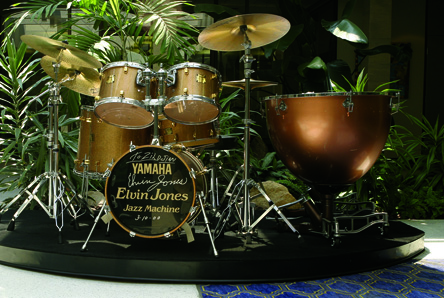BY CHET FALZERANO, JASON LACHAPELLE & ANDY DOERSCHUK
(Above) One of Elvin’s classic kits – with Gretsch drums and Zildjian cymbals – featuring an 18" bass drum, a popular size among jazz drummers of the day.
Even though Elvin Jones cymbals and drumming are unlike anybody else’s, at least part of his style was a result of the drums he played. He recalled, “In 1957 I joined J.J. Johnson’s group to first make one or two LPs for Columbia Records and then to tour in Sweden and Europe for a summer. Not being related to the Rockefellers, I had a set of drums that Jo Jones would put his hands over his eyes when he saw them.
“J.J. said, ’I can arrange for you to buy a set of drums from the Gretsch Company.’ He loaned me the $350 [to buy the set], which he deducted from my salary every week. Nice guy! That is how I got to meet Phil Grant [head of promotions and sales for the Fred Gretsch Manufacturing Company]. Phil asked me then to be an endorser for the company and the use of my name [for advertising purposes].”
Small drum sizes were popular with jazz drummers of the day — 20″ and 18″ bass drums (Elvin even used a 16″ bass drum), 12″ and 14″ toms, and thin 4″ snare drums. Gretsch pioneered the small bass drum with the help of Davey Tough in the late ’40s, but Elvin Jones defined the small bass drum sound, sounding more like a high-pitched “boing” than the chest-thumping “boom” everyone was accustomed to hearing.
Louie Bellson recalls Elvin’s unique small bass drum sound: “Buddy Rich and I were in London together. Buddy was there with his big band and I was there with Oscar Peterson. We both had the night off so we looked in the paper and saw that Elvin was playing at Ronnie Scott’s.
We both said, ’Let’s go!’ We chose seats right in front of his bass drum. Buddy Rich and I both had big 24″ bass drums. I remember Buddy leaning over to me and asking, ’How does he get that sound out of that little bass drum?’”
Like Art Blakey, “Philly” Joe Jones, and Tony Williams, Elvin also knew how to draw the sound out of his cymbals. While a casual observer might think he was bashing his K. Zildjians (they seemed to flap like the wings of a bird), Elvin could make a cymbal sound like no one else. With Coltrane, Elvin used 14″ hats, an 18″ crash, and a 20″ or 22″ ride with a few rivets.
The legendary “old K.” sound permeates all his recordings from this period. Later, he was the inspiration for, and instrumental in the creation of the popular Avedis Zildjian K. Constantinople series. He played two 20″ rides from that series, and also liked to experiment with different cymbals, such as the A Classic Orchestral cymbal that was heavier, with a very flat attack.
The landscape changed in the mid-’80s, when Elvin began playing and endorsing and Tama drums — a relationship that lasted until 1996, when Takahashi “Hagi” Hagiwara signed Jones as a Yamaha endorser. The company subsequently built four identical Absolute Maple kits for Elvin, all finished in Gold Sparkle with gold-plated Absolute lugs.

One of Elvin’s late-period Yamaha kits, on display at the Zildjian factory.
While these were the only Gold Sparkle kits that Yamaha ever made, the shell make-up was standard, with 6-ply toms and a 7-ply bass drum. His sizes were 12″ x 8″ and 13″ x 9″ rack toms, 16″ x 16″ and 18″ x 16″ floor toms, and an 18″ x 14″ bass drum.
That’s right — his low floor tom was actually bigger than his bass drum! Yamaha also made a ten-lug, 7-ply maple Gold Sparkle custom snare with polyurethane-coated 19-ply maple Vintage hoops, and high-carbon steel 20-strand snares, which is still available in music shops.
His hardware choices were mostly straightforward: three double-braced cymbal boom stands (set up as straight stands), a single pedal (he alternated between whatever was Yamaha’s latest chain-drive model and his trusty old Camco), and a heavy-duty snare stand.
But due to Elvin’s penchant for sitting high (he practically stood, in fact), Yamaha had to improvise when it came to Elvin’s throne. “We had to give him the base of a double tom stand and put the top of a drum throne in it, just to make sure it went high enough,” remembers Joe Testa, Artist Relations Manager for Yamaha Drums.
Pro-Mark were his sticks of choice and coated Remo Ambassadors graced all of Elvin’s drums, although he wasn’t exactly a finicky endorser. “He wouldn’t change the heads unless they broke,” Testa laughs. “And believe it or not, he didn’t break heads that much.
It’s in the way he played. He was able to get so much sound out of the drum, but he didn’t throw the stick through the head; he pulled the sound out of the drum. I remember seeing some of his kits that had heads that were from the ’70s or ’80s.”
Elvin’s final kits are now displayed at Zildjian’s Massachusetts headquarters and at Yamaha’s west coast office in California. Standing next to Elvin Jones’ drum kit in the foyer of the historic Avedis Zildjian Company, one is struck by the fact that the symphony of sound he created was superhuman, and yet his drums and cymbals appear to be just like any other.
In a sense it is nothing more than a collection of wood and metal, but we stand before it electrified because of Elvin’s spirit, which is still thundering through it.
“Every day at work when I walk by Elvin’s drum kit, I remind myself how lucky all of us were to have known him,” says Craigie Zildjian. “That big smile, the deep growly voice, his great sense of humor, and most of all the way he could make you feel so good.”
